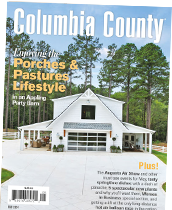
GRU maintenance supervisor Tim Dobbs checks on the observation beehive he built and installed on the Summerville campus in collaboration with biology professor Donna Wear.
New beehive on the GRU Summerville campus highlights the vital role of honeybees
It’s always good to “bee” aware of the world around you, but sometimes the absence of something is just as important as its presence. The United States’ honeybee population has been in steep decline over the last decade or more, but a special addition to Georgia Regents University is teaching students to be part of solution.
An observation beehive in the Shetfall-Cleckley Greenhouse at GRU’s Summerville Campus was installed in April in hopes that students learn and see firsthand how integral the honeybee is to the earth’s ecological system. GRU Facilities Management Maintenance Supervisor Tim Dobbs, an amateur bee enthusiast, built and installed the hive.
Professor Donna Wear’s Evolutionary Biology class was the first group to visit the observation hive this spring.
“Honeybees are fascinating social organisms from both an ecological and evolutionary perspective. Pollinators are crucial to our global production of food. In fact, about one-third of the human diet comes from insect-pollinated plants, and the honeybee is responsible for 80 percent of that pollination, according to the U.S. Department of Agriculture,” Wear says.
The insect’s vital role in food production is why their disappearance is so concerning. Scientists have yet to isolate a single cause of the honeybees’ demise, called colony collapse disorder, but a certain type of pesticide introduced in the 1990s has been known to interfere with a bee’s homing ability.
“The observation hive provides a wonderful teaching and learning opportunity for students of all ages, who need to be reminded of the ecological processes that feed us,” Wear says
Pollinator Friendly Practices
The declining population of honeybees, one of the world’s leading pollinators, is a cause for concern because of the insect’s vital role in food production. However, there are ways that you can help revive the populations of honeybees and other pollinators.
- Use native plants that are adapted to the local climate and soils.
- Plant a variety of flowers to bloom continually from early spring to early fall.
- Provide bare ground or a shallow birdbath filled with soil, sprinkled with sea salt and kept moist to create a source of water and minerals for pollinators.
- Include plants for caterpillars, which require particular host plants. Caterpillars eat the foliage of their host plants, but the average gardener won’t notice the damage until at least 10 percent of the leaves are affected.
- Help pollinators find the plants they need by planting them in clumps rather than singly. Clustering plants also shortens the distance that pollinators need to travel.
- Provide a variety of flower shapes and colors since different pollinators are attracted to different types of flowers.
- Build a bee condo or leave dead trees or limbs to create nesting habitat for bees
- Avoid using pesticides if at all possible. If you want butterflies, then you need caterpillars – and the nibbled leaves that go with them!
- Avoid modern hybrids, especially those with “doubled” flowers, since pollen, nectar and scent can be lost in the cultivation process.
Source: Garden Media Group 2014 Garden Trend Report










